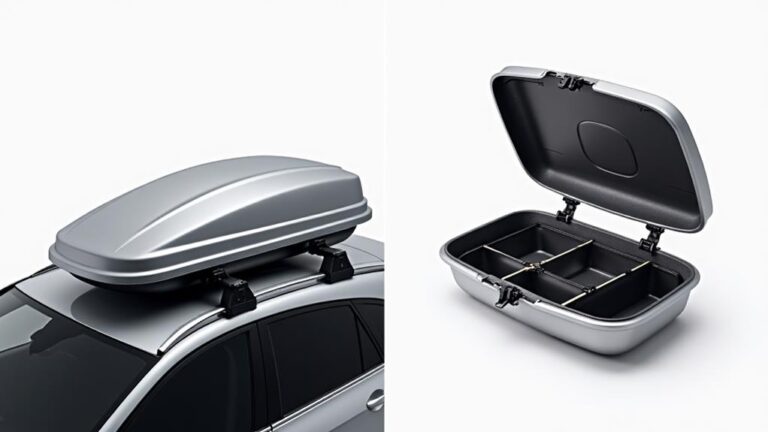When the camping season ends, vital storage of your rooftop tent is paramount to maintain its quality and longevity. You've invested in a premium tent, and now it's time to give it the care it needs when it's not in use. You'll want to shield it from harsh weather conditions and pests that can cause damage. But where do you start? Selecting the right storage location is pivotal, and there are several factors to weigh, from climate control to ventilation. What are the key considerations for storing your rooftop tent at home?
Key Takeaways
- Store the rooftop tent in a dry, climate-controlled garage or well-ventilated attic space to shield it from harsh weather conditions.
- Clean the rooftop tent thoroughly, including fabric, mesh, zippers, and windows, before storing it to prevent mold and mildew growth.
- Use sturdy storage bins or bags to protect the rooftop tent from dust and debris during storage.
- Designate separate compartments or bags for poles, stakes, and other accessories to prevent loss or damage.
- Check the stored rooftop tent periodically for signs of moisture, mold, mildew, or pests, and take action if necessary.
Choosing a Storage Location
When it comes to storing your rooftop tent, you'll want to choose a location that protects it from the elements and keeps it easily accessible.
Consider utilizing your garage organization system to its full potential. A dry and climate-controlled garage is ideal for storing your rooftop tent, as it shields it from harsh weather conditions and potential pests.
Make sure to choose a spot that's close to the garage door for easy access.
Alternatively, if your garage is too cluttered, you can also consider using your attic space.
Verify the attic is well-ventilated, dry, and free from pests. Use sturdy storage bins or bags to protect your rooftop tent from dust and debris.
When storing in the attic, it's vital to maintain good attic ventilation to prevent moisture buildup and damage to your gear.
Regardless of your chosen storage location, make sure to keep your rooftop tent off the floor to prevent damage from moisture and pests.
Preparing Your Rooftop Tent
| Area to Clean | Cleaning Tips |
|---|---|
| Fabric and mesh | Use a soft-bristled brush to remove dirt and debris. For tough stains, use a mild soap solution. |
| Zippers and poles | Use a dry cloth to wipe away dirt and debris. Apply silicone-based lubricant to guarantee smooth operation. |
| Windows and doors | Use a glass cleaner and a soft cloth to clean windows. For doors, use a mild soap solution. |
| Floor and walls | Sweep away dirt and debris. Use a mild soap solution to clean any stubborn stains. |
Tent inspection is also vital in preparing your rooftop tent for storage. Check for any signs of wear and tear, such as tears, holes, or broken zippers. Make any necessary repairs before storing your tent to guarantee it remains in good condition. Regular cleaning and inspection will extend the lifespan of your rooftop tent and keep it in excellent condition for your next adventure.
Protecting Against Pests and Mold
How effectively you protect your rooftop tent from pests and mold can substantially impact its lifespan and usability.
When storing your rooftop tent at home, it's vital to take measures to prevent pests and mold from damaging your investment.
To safeguard your rooftop tent, consider the following steps:
1. Clean and dry your rooftop tent: Before storing your rooftop tent, confirm it's clean and dry.
This will prevent mold and mildew from growing.
2. Use rodent repellents: Rodents can chew through fabric and damage your rooftop tent.
Use rodent repellents to deter them from nesting in your tent.
3. Install moisture barriers: Moisture can seep into your storage area and cause mold and mildew to grow.
Install moisture barriers to keep your rooftop tent dry and protected.
Storing the Tent and Accessories
You've taken the necessary steps to protect your rooftop tent from pests and mold; now it's time to weigh the best storage options for the tent and its accessories.
When storing the tent, consider using proper tent folding techniques to minimize creases and prevent damage. Refer to your rooftop tent's manual for specific folding instructions, as different models may have unique requirements.
Proper folding will also help you make the most of your storage space.
Look for a dry, well-ventilated area with enough room to store the folded tent and its accessories. Consider using a large storage bag or container to keep everything organized and protected.
Accessory organization is also vital for efficient storage.
Designate separate compartments or bags for poles, stakes, and other accessories to prevent them from getting lost or damaged. Label each compartment or bag to guarantee you can easily find what you need when you're ready to set up your rooftop tent again.
Maintenance During Storage Period
During your clean inspection, look for signs of moisture, mold, or mildew, and check for any damage to the fabric or poles.
Make sure the tent is properly ventilated to prevent moisture buildup. Dry ventilation is vital to preventing damage to your tent.
- Check for pests: Rodents, insects, or other pests might be attracted to the tent's fabric or insulation. Look for signs of infestation and take action if necessary.
- Verify waterproofing: Inspect the tent's waterproof coating and reapply it if necessary to safeguard your tent remains waterproof.
- Lubricate moving parts: Apply lubricant to any moving parts, such as zippers or hinges, to keep them running smoothly.
Frequently Asked Questions
Can I Store My Rooftop Tent in a Humid Basement?
You shouldn't store your rooftop tent in a humid basement, as it can foster mold growth and damage the fabric. Instead, consider a dry, well-ventilated area with good basement organization to maintain its condition.
How Often Should I Inspect Stored Rooftop Tent Accessories?
You should inspect your stored rooftop tent accessories every 2-3 months, checking for signs of damage or wear. Regular inspections help maintain tent condition, ensuring you catch issues early and follow effective storage tips.
Are Rooftop Tent Storage Bags Worth the Investment?
You weigh the cost, but rooftop tent storage bags are worth it – they safeguard your gear with material durability and weather protection, ensuring your investment lasts, and you enjoy many adventures to come.
Can I Store My Rooftop Tent With Bedding Still Inside?
You can store your rooftop tent with bedding inside, but it's best to remove it to maintain a clean tent and fresh fabric. This prevents moisture buildup and reduces musty odors when you next use it.
How High Can I Stack Rooftop Tent Storage Boxes?
A tower of boxes symbolizes your storage ambitions. When stacking rooftop tent storage boxes, you're usually limited to 3-5 boxes high, depending on their size and weight, to maintain vertical storage stability and safety.
Conclusion
Storing your rooftop tent at home is like putting a car in the garage – you want to keep it sheltered and ready to roll. A well-stored rooftop tent is like a sports car in a climate-controlled showroom, waiting for its next adventure. By following these steps, you'll preserve your investment and guarantee it's ready to hit the road when you are. Proper storage will save you time and hassle in the long run, and your tent will thank you.












